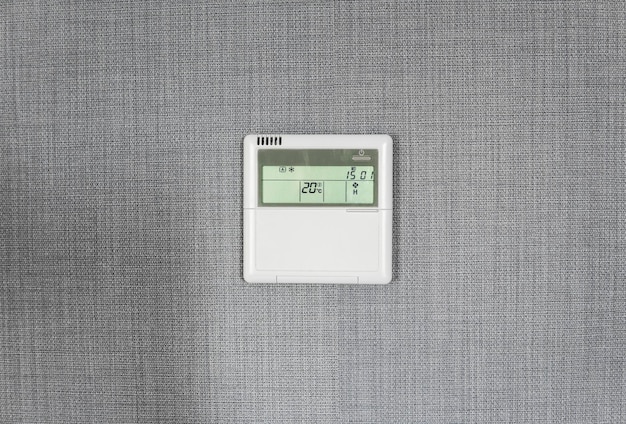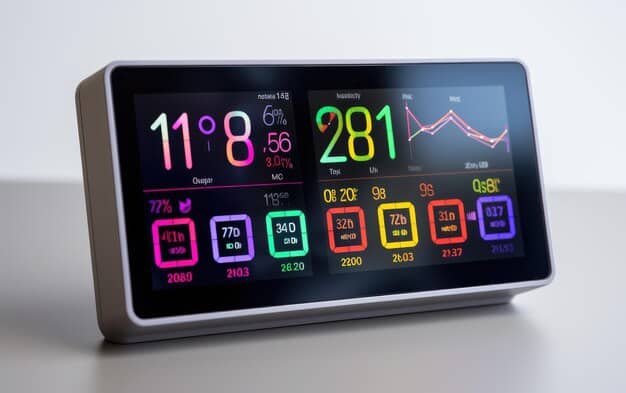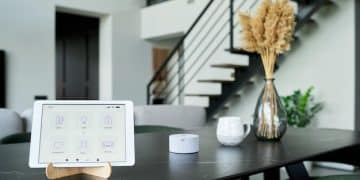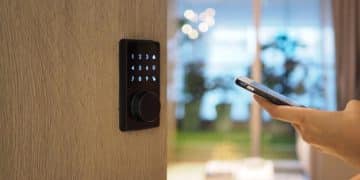Smart Home Sensors: Enhance Comfort and Security with Monitoring

Smart home sensors monitor temperature, humidity, and motion to provide enhanced comfort, security, and energy efficiency, allowing homeowners to create automated and responsive living environments.
Imagine a home that intuitively responds to your needs, adjusting the temperature, lighting, and security based on real-time conditions. That’s the power of smart home sensors: Monitoring Temperature, Humidity, and Motion for Enhanced Comfort and Security. These devices are becoming increasingly essential for modern living, offering a seamless blend of convenience, safety, and energy efficiency.
Understanding Smart Home Sensors
Smart home sensors are devices designed to detect and measure various environmental conditions within a home. These sensors play a critical role in automating and enhancing the functionality of a smart home ecosystem. By monitoring parameters such as temperature, humidity, and motion, these sensors enable homeowners to create a more comfortable, secure, and energy-efficient living environment.
These sensors not only collect data but also communicate it to a central hub or control system. This enables automated responses, such as adjusting the thermostat, turning on lights, or sending alerts to a smartphone. Understanding how these sensors work and their potential benefits is the first step in transforming your home into a smart home.
Types of Smart Home Sensors
Smart home sensors come in various forms, each designed to monitor specific aspects of your home environment. Here are some of the most common types:
- Temperature Sensors: These sensors measure the ambient temperature and can be used to automatically adjust heating and cooling systems.
- Humidity Sensors: Humidity sensors detect the level of moisture in the air, helping to prevent mold growth and maintain optimal comfort levels.
- Motion Sensors: These sensors detect movement within a designated area, enhancing security and enabling automated lighting systems.
- Door/Window Sensors: These sensors monitor whether doors and windows are open or closed, providing an added layer of security.
Each of these sensors contributes to a smart home’s overall functionality, allowing homeowners to create customized and responsive living spaces.
In addition to the basic types of sensors, there are also more specialized devices available, such as water leak sensors and air quality sensors. These advanced sensors can provide even greater levels of protection and control over your home environment.
Benefits of Smart Home Sensors
Integrating smart home sensors into your living space offers a multitude of benefits, from enhancing comfort to improving security. These devices provide homeowners with unprecedented control over their home environment, allowing for a more personalized and efficient living experience.
By automating various functions and providing real-time data, smart home sensors can significantly improve your quality of life and reduce energy consumption.

Enhanced Comfort and Convenience
One of the primary benefits of smart home sensors is the ability to create a more comfortable and convenient living environment. Temperature and humidity sensors can automatically adjust HVAC systems to maintain optimal conditions, while motion sensors can turn on lights as you enter a room.
- Automated Climate Control: Maintain consistent temperature and humidity levels throughout your home.
- Smart Lighting: Automatically turn lights on and off based on occupancy.
- Remote Monitoring: Check sensor data and control devices from anywhere using a smartphone app.
- Personalized Settings: Customize sensor settings to match your individual preferences and lifestyle.
The convenience of smart home sensors extends beyond simple automation. These devices can also learn your habits and preferences over time, further optimizing your home environment to suit your needs.
Smart home sensors can also integrate with other smart devices, such as smart blinds and smart fans, to create a comprehensive and responsive home environment. This level of integration allows for a truly seamless and intuitive living experience.
Improving Home Security with Sensors
Smart home sensors are essential for enhancing home security. Motion sensors, door/window sensors, and security cameras work together to create a comprehensive security system that protects your home from intruders and alerts you to potential threats.
These sensors can provide real-time alerts and notifications, allowing you to take immediate action in the event of a security breach.
Real-Time Monitoring and Alerts
Smart home security sensors provide real-time monitoring of your home, alerting you to any suspicious activity. Door/window sensors can detect if a door or window is opened unexpectedly, while motion sensors can identify unauthorized movement within your property.
These sensors can trigger alerts sent directly to your smartphone, allowing you to monitor your home from anywhere in the world.
- Instant Notifications: Receive alerts on your smartphone when sensors detect unusual activity.
- Remote Monitoring: Check the status of your sensors and security cameras from anywhere.
- Automated Responses: Set up automated responses, such as turning on lights or sounding an alarm, when a security breach is detected.
Motion sensors can be strategically placed to cover entry points and high-traffic areas, providing an additional layer of security. Some motion sensors are also equipped with pet-immune technology, which prevents false alarms caused by pets.
Smart home security systems can also integrate with professional monitoring services, providing 24/7 protection and peace of mind. These services can dispatch emergency responders to your home in the event of a security breach.
Energy Efficiency and Savings
One of the most significant advantages of smart home sensors is their ability to improve energy efficiency and reduce utility costs. Temperature and humidity sensors can optimize HVAC systems, while occupancy sensors can turn off lights in unoccupied rooms.
By automating energy-saving measures and providing detailed usage data, these sensors can help you minimize your carbon footprint and save money on your energy bills.

Optimizing Energy Consumption
Smart home sensors can significantly reduce energy consumption by optimizing the operation of HVAC systems and lighting. Temperature sensors can automatically lower the thermostat when you’re away from home, while occupancy sensors can turn off lights in empty rooms.
- Automated Thermostat Control: Automatically adjust the thermostat based on occupancy and time of day.
- Smart Lighting: Turn off lights in unoccupied rooms to save energy.
- Real-Time Data: Track energy usage patterns and identify areas for improvement.
The data provided by smart home sensors can also help you identify energy-wasting behaviors and make informed decisions about energy consumption. For example, you may discover that you’re leaving lights on in certain rooms or that your HVAC system is running inefficiently.
By analyzing your energy usage data, you can implement targeted strategies to reduce your energy consumption and lower your utility bills. This not only saves you money but also helps to protect the environment.
Choosing the Right Smart Home Sensors
Selecting the right smart home sensors can be a daunting task, given the wide range of options available. It’s important to consider your specific needs and priorities when choosing sensors for your home.
Factors such as compatibility, ease of installation, and integration with other smart devices should all be taken into account when making your decision.
Factors to Consider
When choosing smart home sensors, consider the following factors to ensure you select the best options for your home:
- Compatibility: Ensure that the sensors are compatible with your existing smart home ecosystem, including your hub and other smart devices.
- Ease of Installation: Choose sensors that are easy to install and set up, especially if you’re not a tech-savvy individual.
- Reliability: Look for sensors with a reputation for reliability and accuracy.
- Features: Consider the features offered by each sensor, such as remote monitoring, real-time alerts, and integration with other smart devices.
Before purchasing any smart home sensors, research different brands and models to find those that best meet your needs and budget. Read customer reviews and compare specifications to make an informed decision.
It’s also important to consider the overall cost of the smart home system, including the price of the sensors, the hub, and any ongoing subscription fees. Make sure to factor in all of these costs when making your decision.
Installation and Setup Tips
Proper installation and setup are crucial for ensuring that your smart home sensors function correctly and provide accurate data. Following these tips can help you get the most out of your smart home system.
Careful planning and attention to detail during the installation process can prevent issues down the road and ensure that your sensors provide reliable and accurate information.
Best Practices for Installation
Follow these best practices to ensure a smooth and successful installation of your smart home sensors:
- Read the Instructions: Carefully read the instructions provided by the manufacturer before beginning the installation process.
- Placement: Choose the optimal location for each sensor to ensure accurate data collection.
- Connectivity: Ensure that the sensors are within range of your smart home hub or Wi-Fi network.
- Testing: Test each sensor after installation to verify that it is functioning correctly.
When placing sensors, consider factors such as sunlight, drafts, and obstructions that could affect their accuracy. For example, temperature sensors should be placed away from direct sunlight and heat sources.
After installing your sensors, take the time to configure their settings and customize their behavior. This may involve setting temperature thresholds, motion detection zones, and alert preferences.
| Key Point | Brief Description |
|---|---|
| 🌡️ Temperature Sensors | Monitor and regulate home temperature automatically for comfort and energy savings. |
| 💧 Humidity Sensors | Detect moisture levels to prevent mold and maintain optimal air quality. |
| 🏃 Motion Sensors | Enhance security and automate lighting by detecting movement. |
| 🔒 Door/Window Sensors | Provide an extra layer of security by monitoring entry points. |
[Frequently Asked Questions]
▼
Smart home sensors are devices that monitor environmental conditions and send data to a central hub. They measure factors like temperature, humidity, and motion, enabling automated actions based on the data collected.
▼
These sensors optimize HVAC and lighting systems by adjusting settings based on occupancy and environmental conditions. For example, a temperature sensor can lower the thermostat when you’re away.
▼
Smart home sensors enhance security through motion detection, door/window monitoring, and real-time alerts. They can notify you of unauthorized activity and even trigger alarms.
▼
Many smart home sensors are designed for easy installation, often requiring no specialized tools or expertise. Follow the manufacturer’s instructions for proper setup and placement.
▼
Consider compatibility with your existing smart home system, ease of installation, reliability, and the specific features offered by each sensor to meet your unique needs.
Conclusion
Smart home sensors: Monitoring Temperature, Humidity, and Motion for Enhanced Comfort and Security are transforming the way we live, offering a seamless blend of convenience, security, and energy efficiency. By integrating these devices into your home, you can create a living environment that is both responsive and intuitive, enhancing your overall quality of life.





